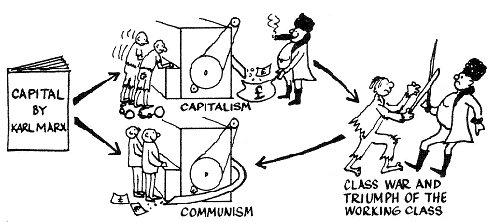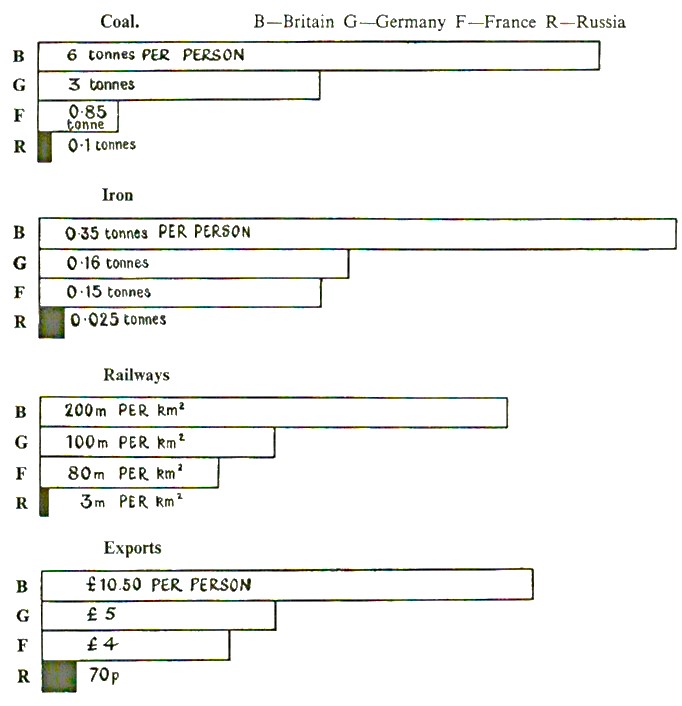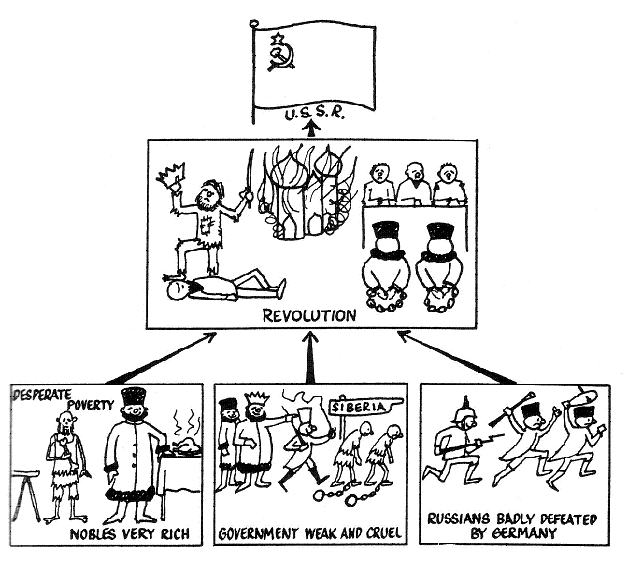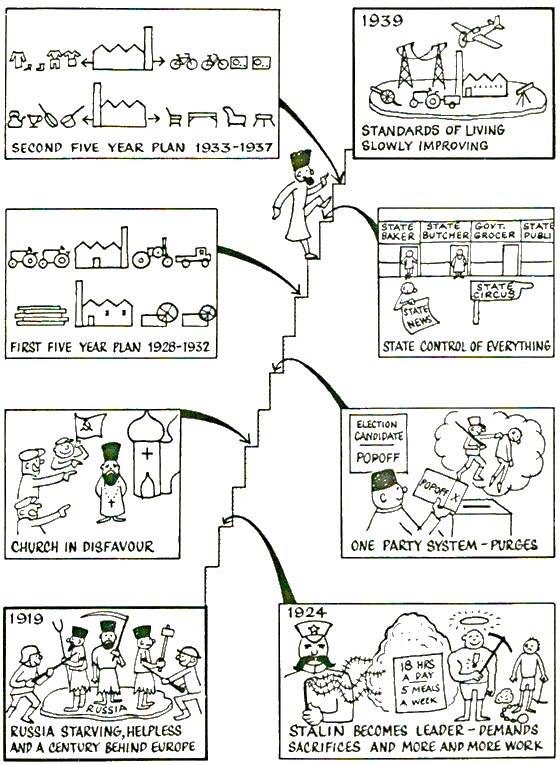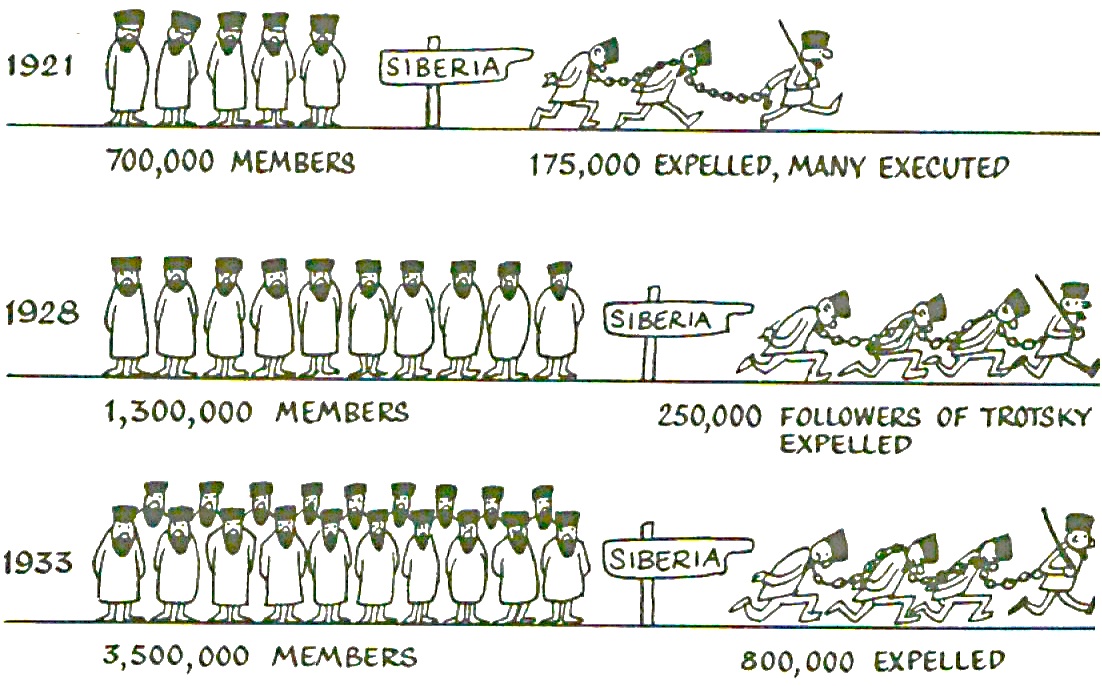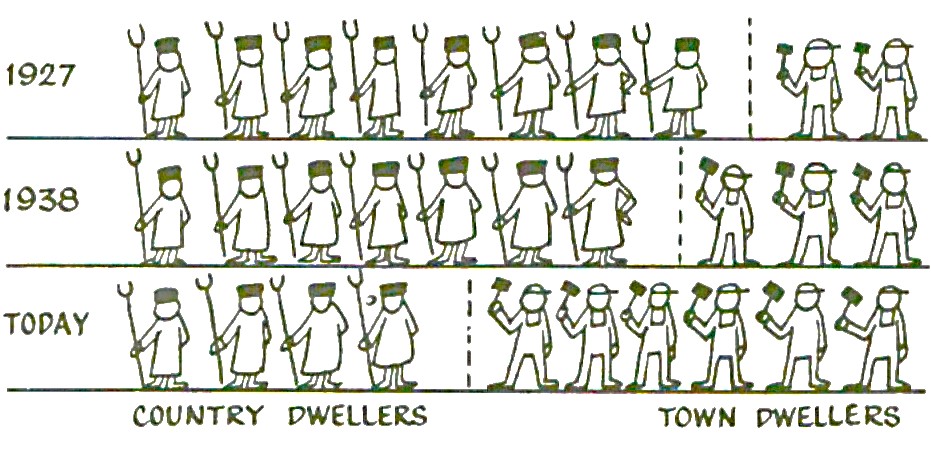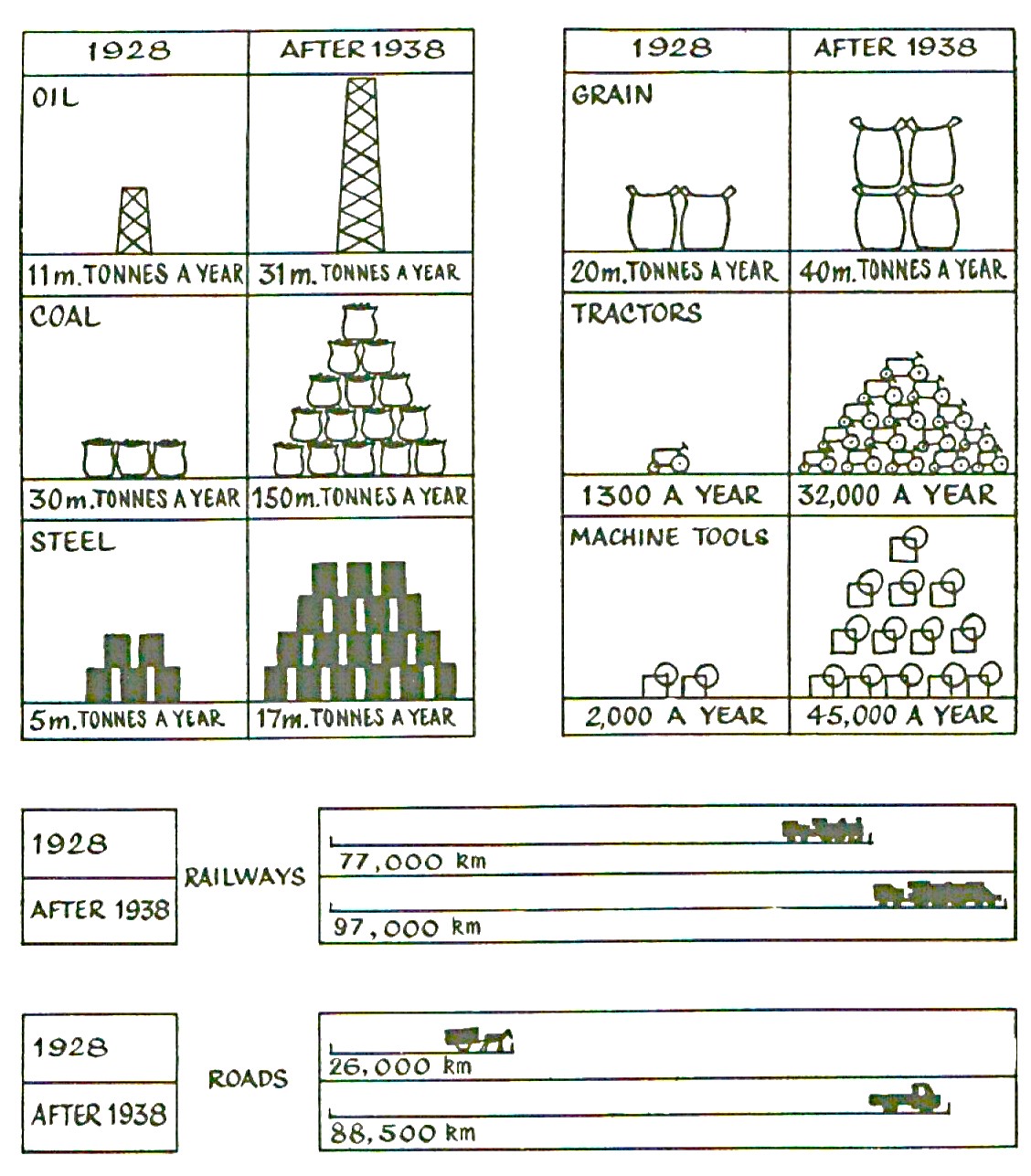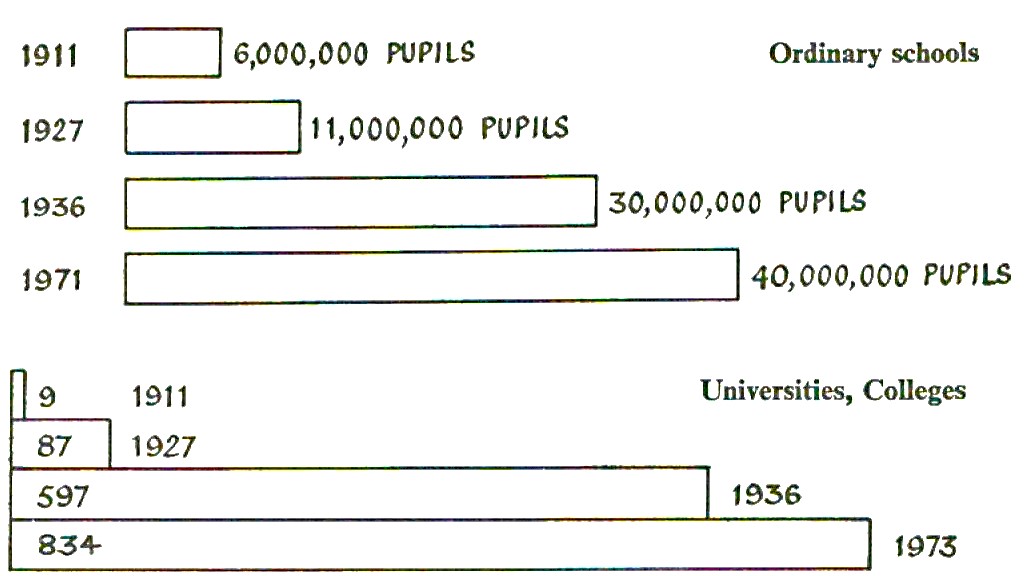|
|
|
History Alive!
Communism Backward Russia The Russian Government The February Revolution The October Revolution Stalin's Russia Stalin's Terror The Five Year Plans Education Summary
|
RememberWhen you are reading this, remember that Peter Moss was writing at a time when Communism was a popular belief, and Russia was a very powerful Communist countryd.
|
Communism and the Russian Revolution of 1917
|
|
|
The political belief called communism began with a Jewish lawyer named Karl Marx who was forced to flee to London from his native Germany in 1849 for supporting the working people against their masters. In 1867 he wrote a book called Das Kapital (Capital) in which he said that the capitalists -that is, the rich owners of factories, lands and shops - were treating the working class like slaves, and making bigger and bigger fortunes for themselves from the workers' efforts. Marx went on to say that the capitalists would go on growing richer and richer, and that the working class would become poorer and poorer until there was a war between the two classes. The poor, Marx said, would win this struggle: they would take over control of all industry, land and commerce, and would enjoy the profits for themselves. The workers would even govern the country one day, Marx continued, but at the time this seemed impossible. The destruction of the aristocracy, the rise of the working class and the ownership of all industry and land by the state is the essence of modern communism, which tends to be strongest in underdeveloped countries where the workers are desperately poor and oppressed by the ruling class. Naturally, the poorer the people, the more they long for the luxuries they see the rich enjoying, and they look to communism to give them what they consider a fairer share of the good things of life.
|
Communism |
|
Before 1917 Russia was very poor and underdeveloped, and in many ways was more like a country of the middle ages. The amount of coal and iron produced, the length of the railways and the value of exports each year gives a good idea of the state of development of a country in the early years of the twentieth century. Here are the figures for Britain, Germany, France and Russia for the years 1906-8. The figures for iron, coal and exports are given per head of the population, and the railways in metres for every square kilometre of territory. This gives a true picture of just how underdeveloped Russia was.
To add to this, in Russia an average of 8 people in every 10 could neither read nor write: in Britain, Germany and France illiteracy had almost vanished.
|
Backward Russia |
|
All the power rested with the Czar, or king, backed by a small group of powerful nobles and the church. The majority of people were treated little better than animals, with never enough food, clothing or shelter. Much of the money they did earn was taken from them in the form of taxes by the greedy landowners, who lived in magnificent luxury. The government was weak and powerless when dealing with the nobles, but savage and cruel when dealing with the workers. For a very small offence a man could be sent to prison, or to exile in the mines of Siberia where often cold and appalling conditions put an end to his sufferings. The officials - police, tax-collectors, judges - were as much tyrants as the nobles, and were usually corrupt and easily bribed...
|
The Russian government |
|
There had been a minor revolution in 1905, and as a result the Czar had been forced to allow a parliament of sorts, called the Duma, to be elected. It had little power, however, and the Czar could overrule any measures it passed. Having at last a parliament, only to find it completely useless, made the people more bitter than ever in their hatred of the ruling class. So Russia struggled on, and in 1914 entered the war against Germany on behalf of her Serbian allies. By 1917 her armies had suffered dreadful losses and were close to defeat. The soldiers, brave though they were, could not hope to win with the old-fashioned weapons they were given and with the poor way in which they were led. While the men at the front were half-frozen, half-fed, and equipped often with only one rifle between every two or three men, the majority of the generals were enjoying themselves far from the war, safe, and making money in a dozen illegal ways. By February 1917 the Russian people could stand it no longer. After a hard winter there was a desperate shortage of food, and many workers went on strike. The Czar sent soldiers to deal with the strikers, but a part of the army mutinied and joined them in their protest. Immediately the country was in an uproar: in the confusion the Czar and his family were seized and imprisoned. Alexander Kerensky, a member of the Duma, formed a government and declared Russia a republic.
|
The February Revolution |
|
| |
|
The new government wanted to continue the fight against Germany. but all that most Russians wanted was peace. so the confusion grew steadily. Meanwhile the Germans smuggled into Russia one of Karl Marx's most devoted followers called Lenin. He had been exiled by the Czar be-cause of his revolutionary ideas, and now he saw his job as organising the army. navy and workers into a communist army. While the rioting was at its height. Lenin and his communists, who were really the only organised party, stepped in and seized power. Kerensky's government was turned out, and a communist one under Lenin took its place. This was the October Resolution which the Russians celebrate every year. Immediately the lands and homes of the nobles were seized, and many of the aristocrats were killed. When the soldiers on the battle front heard this, they mutinied. sometimes murdering their officers, and fled hack to their homes. Lenin at once signed a peace treaty with the Germans which gave away vast areas of the country: for Russia the World War was over, but an even more bitter conflict was just beginning. In July 1918 the Czar was murdered. Kerensky failing to gather an army fled to England but terrible civil war began between those opposing Lenin (Whites) and the communists (Reds). By the time of the Whites' defeat in 1920 the whole of Russia was starving and on the point of complete collapse. In a communist state, however, everything belongs to the people, so the peasants and workers, who were no longer toiling for a nobleman's profit but for their own good, threw themselves into the almost impossible task of rebuilding their shattered and ruined country. In 1922, four of the se-parate Russian communist countries joined together under the leadership of Lenin to form the Union of Soviet Socialist Republics. The U.S.S.R. which was to become such a powerful influence on the history of the world had been born.
|
The October Revolution |
|
The story of the U.S.S.R. between 1919 and 1939 is almost like a fairy tale, and most of the incredible success is due to one man, Joseph Stalin whose energy, cruelty and ruthlessness turned Russia from an almost ruined wasteland to a mighty nation in twenty years. In 1919 Russia was a century behind most of Europe in many ways : she had little machinery, little trade and industrial methods were hopelessly out-of-date. Twenty years later she had leapt forward a hundred years with industry, communi¬cation and machinery which compared favourably with any but the most highly developed countries, such as the United States, Britain and Germany. But no country can move forward at such a rate without a great deal of suffering: so it was with Russia.
Lenin, the leader of the revolution, died soon after the civil war had ended after an assassin's bullet provoked a heart condition and a series of strokes, and was followed as dictator of Russia by Joseph Stalin. Cruel, cunning and completely without pity, Stalin saw that his country could not rest now that the revolution was over. In fact, the people must now work harder than ever before and manage with less and less food and fewer and fewer goods as the civil war had destroyed much that did exist. Life for the Russians was bitter indeed, with long hours of work; back¬breaking labour with inefficient tools; little food, comfort or leisure. Sacrifice after sacrifice was demanded by the leaders to repair the shattered country and to ensure that the new communist state survived, for almost every country in the world would have liked to see it perish. The Russian people already knew what hard work meant, for their former masters, the nobles, had driven them hard with threats of punish-ment: but now most of them worked willingly for they realised that in the end they were toiling for themselves. The only large group which did object were the wealthy peasant farmers, or Kulaks, for whom the new way of life seemed worse than their old one. Rather than hand over their farms to the government collective scheme they slaughtered their cattle and burnt the crops. As a punishment, and a warning, it is thought that over a million were sent to labour camps or executed. Stalin knew that if one small group succeeded in defying the government, the rest might follow, and the whole communist system might collapse. The Church in Russia was immensely powerful, and was often as cor¬rupt as the nobles had been. Stalin saw that its influence must be checked as it was no friend of the communist party. He did not outlaw religion, as this would have offended many people, for the Russians are very devout, but he carried on a campaign against the church by mocking the priests, turning many of their buildings into museums and discouraging younger people from attending services. Later on, when the communist government felt more secure, this attitude was relaxed a little.
|
Stalin's Russia |
|
Stalin saw that if the country was to be driven to success there could be no arguing in the Supreme Soviet, or parliament, so all parties except the communists were banned. There were elections, but the voting papers contained a single list of names, all communists, and the voters had to in¬dicate whether they approved of the list or not. Anyone who opposed the party in any way—and thousands who were perfectly innocent and whose only crime was that they had made an enemy of a party official—was ruthlessly hunted down by the OGPU (later the NKVD), the secret police, and imprisoned or murdered. Millions, perhaps, whose only crime was that Stalin thought they might grow popular enough to compete with him, were killed in the great Purges, which are the greatest blot on Stalin's career.
No one knows how many people were executed in the Great Purge of 1934-38 which followed. Estimates vary from 1,000,000 to 10,000,000. Perhaps similar numbers went to labour camps. Party and non-party members were killed indiscriminately. The higher ranks of the Red Army suffered particularly badly and when the war came the loss of the experienced senior officers was felt badly.
|
Stalin's Terror |
|
Progress in building the U.S.S.R. into a modern state was slow until the first Five Year Plan was drawn up in 1928. Everything was now plan¬ned by the government for a great advance in industry and agriculture. Everyone toiled at the job he or she had been given—for men and women worked side by side in all tasks—and the newly built factories began turn¬ing out tractors, lorries, heavy machines, railways, hydro-electric power plants and other basic manufacturing equipment in a steady stream, which grew as the years passed. Some people, who had been expecting com¬forts and luxuries from the factories, were disappointed, but it was ob¬vious that the vital machinery must come first. By 1933 the industry and agriculture of the U.S.S.R. were turning out more than they had ever done in history. Immediately the first Five Year Plan ended, a second was organised, and this time there was a little time for the people who had worked so hard to relax. Goods which helped to make life easier—clothing, shoes, radios, household goods, furniture and houses themselves—began to roll from the factories and machinery built in the first Five Year plan, though heavy industrial machinery and transport was still the most important item. Vast new industrial cities began to appear all over the vast country, and the great movement from the country to the towns began.
The changes in production in Russia because of the Five Year plans (1928-1938). The first figure is the production in 1928, the second after 1938.
|
The Five Year Plans |
|
One of the most important of all the aspects of the Five Year Plans was the building of schools and colleges. Before the revolution about two persons in ten in Russia could read and write, and the communists realised that to make their country up-to-date and prosperous the people must be educated. Not only did they need highly-trained scientists and engineers to design and manufacture the new machinery, but also the ordinary work¬men had to be literate to be able to use the complicated equipment. A man did not really need to be able to read to milk a cow or use a scythe, but he did to work a lathe or drive a train. The chart shows how this educational programme was carried out. The number of children at school rose from 6 to 30 millions between 1911 and 1936, and even more remarkable, the nine universities of 1911 had ex¬panded into almost six hundred twenty five years later. In addition, particul¬arly in the 1920's and 1930's there were thousands of schools for adults who had never been fortunate enough to go to school. Here, after work, they could learn to read and write and also how to improve their skills.
|
Education |
|
By the end of the Second Five Year Plan in 1937, the Russians, with production soaring and education immeasurably improved, were much more comfortable, prosperous and powerful than they had ever been. The third Five Year Plan was begun, but unfortunately it was so obvious that war was coming that the factories, instead of turning out cars, refriger¬ators and other luxuries, had to turn to tanks, aeroplanes and guns, so that the consumer march forward was halted for over ten years.
|
Summary |
|
| |
